It was May 1981 when Phil O’Connor took his first race picture; Manxman, Steve Joughin winning a stage of the Tour of Britain, the ‘Milk Race’ as it hurtled into Bournemouth – some months later he managed to get it published in a cycling magazine.
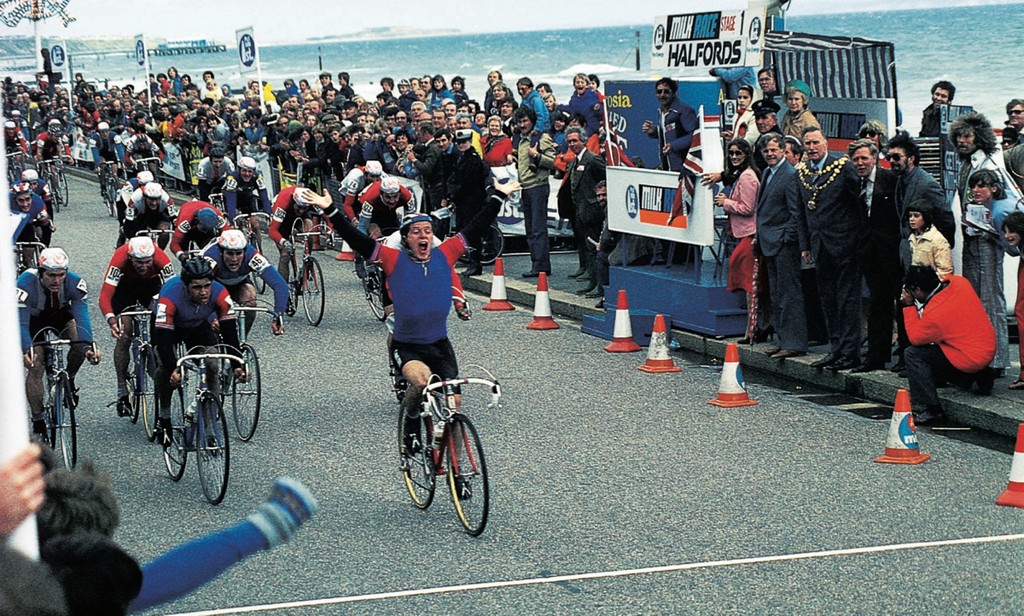
Phil tells us about this image;
“This picture is an important personal milestone for me. Although it is not the first picture I have had published, it is the earliest of my pictures to be published. Great Britain’s Steve Joughin won the stage from team mate Mark Bell, a last minute inclusion in the team, along with fellow Merseysider Phil Thomas.
“Taken in the days when the Milk Race was dominated by anonymous riders from Eastern Europe and the Soviet Union, any British success was a treat, as the outstretched arms of Joughin and of the fan on the left shows.”
Phil freelanced until March 1988 shooting a lot of cycling but also running, ice hockey, football, rugby and basketball for local papers until he got a job at Sporting Pictures and remained there for the next four years; honing his skills, working alongside Fleet Street’s finest photographers he photographed numerous major sports events including the Seoul and Albertville Olympics.
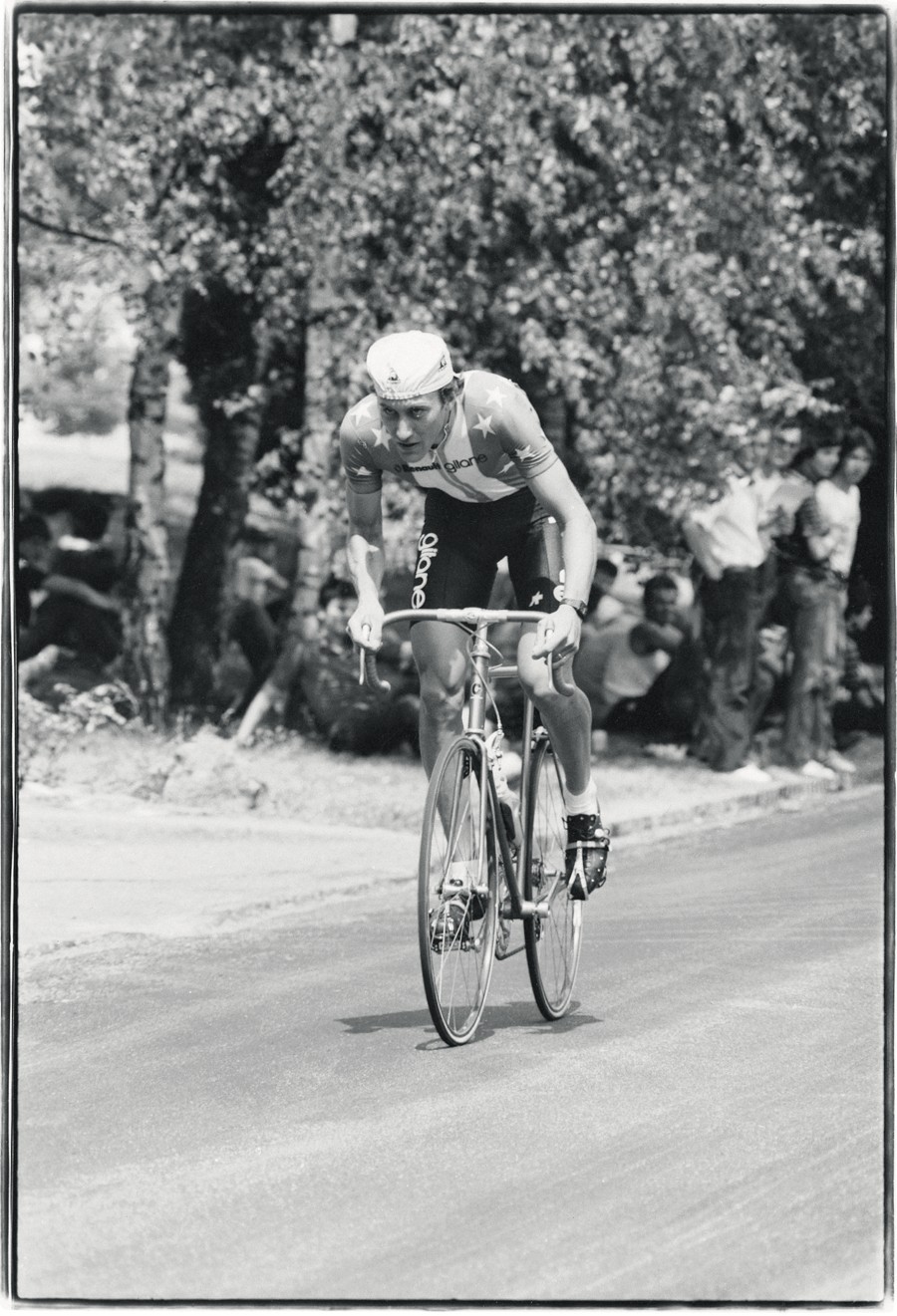
“Well, this is just an ordinary picture of Jonathan Boyer right after the start of the Mulhouse time trial at the 1981 Tour de France.
“Little did I realise as I clicked the shutter on my Nikkormat that this would be the first of my photographs to be published. It was used in a magazine called ProNews, now long defunct, but at the time was a large format magazine with a radical campaigning edge.”
He left in March 1992 to create a brand new transparency library at ‘Cycling Weekly’ magazine.
It’s glossy, monthly ‘twin’ magazine – but now late lamented – Cyclesport was created not long after he joined the weekly magazine and these two magazines became his commitment until May 2006.
During that time he captured images of some of the sport’s most famous – and notorious – protagonists and some of the most historic events of the era.
His hardback book, ‘Phil O’Connor’s 21 Years of Cycling Photography‘ records many of these riders and events.
Phil has kindly consented to allow VeloVeritas to reproduce some of the most memorable pictures from the book.

“Every year I would follow this race on a motorbike and every year I would be too late to take this picture as we zoomed past the spot at 70 mph!
“Eventually I remembered in time and was able to capture the beauty of the Isle of Man, something that the riders probably do not notice.
“The picture is taken at the top of the mountain, Snaefell. The riders in the International have to tackle the six-mile climb three times in the 113-mile race, and anyone who has ridden up it will tell you that once is enough.
“Beyond the hills is the Irish Sea and beyond that is Cumbria in northwest England. If you look closely on the right of the picture you can see the railway line that snakes its way to the top of the mountain from Douglas.
“Belfast’s David McCann in the green and white jersey won the race. As it was Olympic year, the Australians used the race as the selection race for the Atlanta road squad.
“Here you can see Robbie McEwan trailing Ireland’s former Tour de France and Giro d’Italia stage winner Martin Earley, who also went to Atlanta to ride the mountain bike race.”

“I took this photo with about 100 metres to go to the finish in Herezele, Belgium.
“If you want to get a photo of a rider giving 100% then this is a good place to be, and if the photo is of a star like Kelly then you cannot really go wrong.”
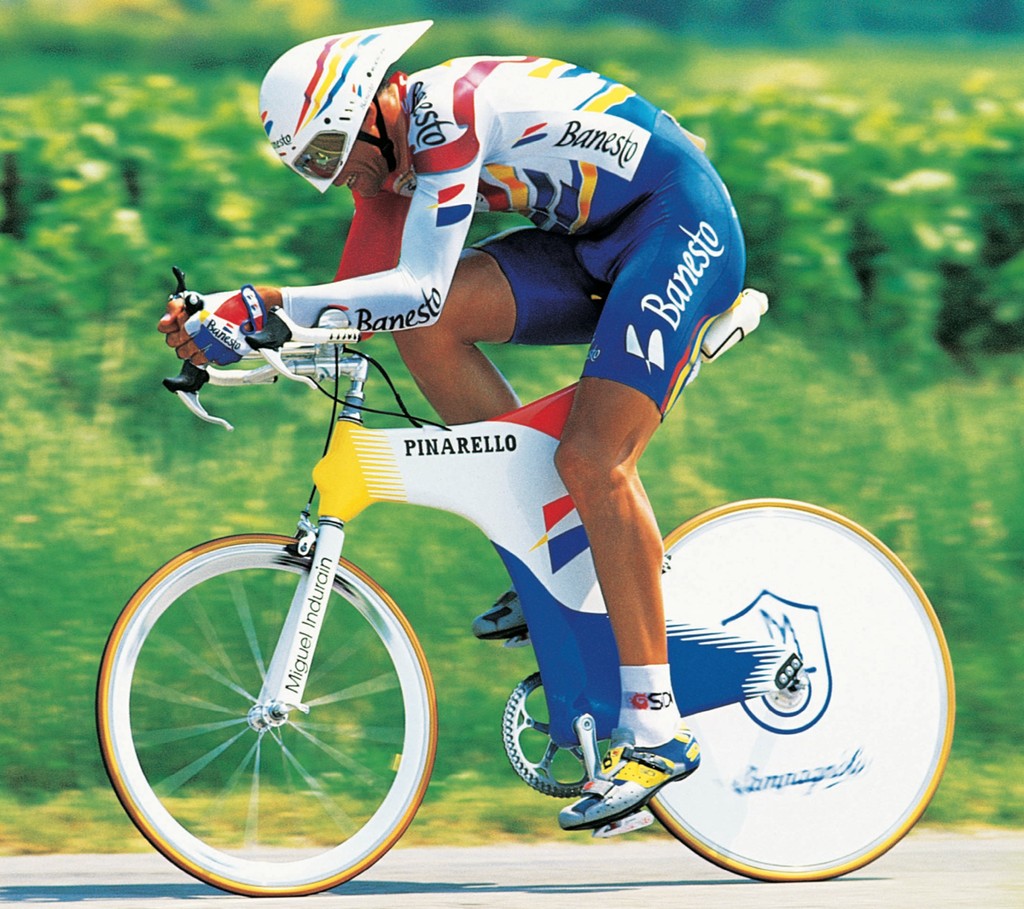
“He may not have had the most aerodynamic position, but Induráin produced a stunning amount of power in time trials along with his famous ‘Espada’ machine with which he regularly crushed his rivals both physically and mentally.
“He was without doubt the master of the time trial, especially in the Tour de France. The time gaps he could build up against his main rivals were such that he rarely had to attack them in the mountains.
“On the few occasions that potential rivals attacked thinking that he was vulnerable, Induráin was able to respond.
‘As a winner of the Tour de France five times in a row, 1991–1995, the man from Navarre will go down in history as one of the all time greats.”

“Unfortunately the Tour no longer uses this climb. It is hardly surprising as the Tour has grown so much that logistically it could not get away with it.
“Just look at the mass of spectators that are forming this human corridor for their hero as he snakes his way around the extinct volcano, which sits like a walnut whip in the middle of a vast plain.
“A difficult shot to get, especially with a large format camera – the only way that you will succeed is by being the last person to get out of the rider’s way!”
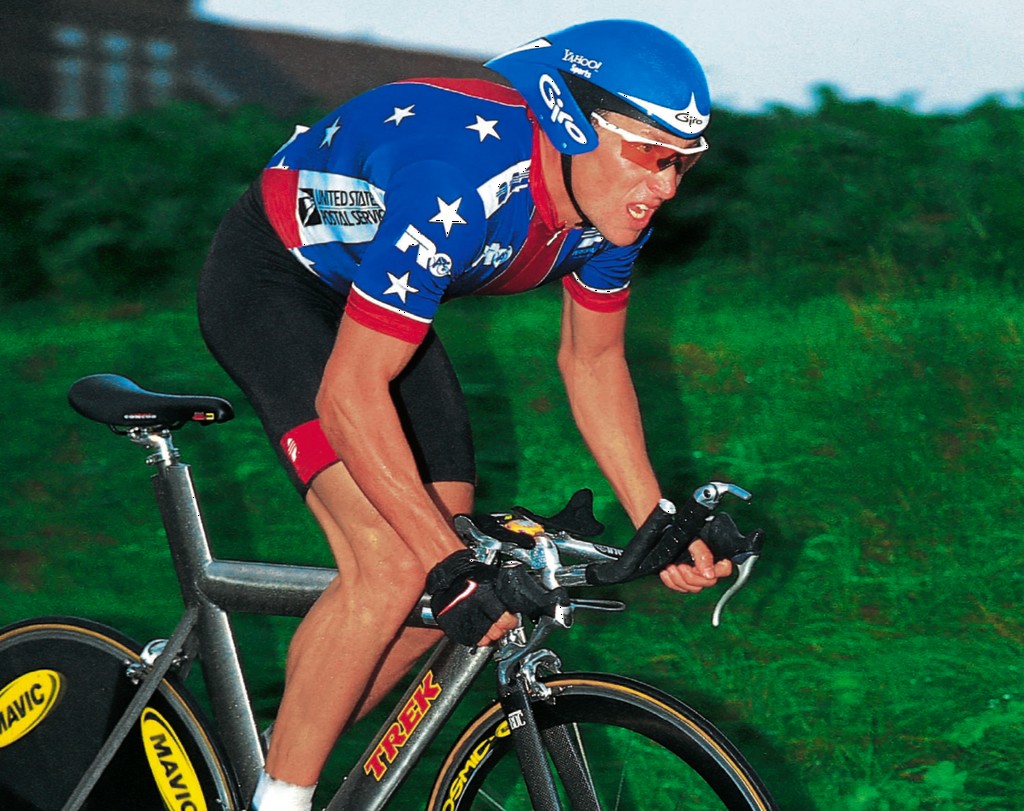
“On a miserable wet day near Maastrict Lance Armstrong wrote the first chapter of his incredible comeback story.
“He finished fourth, just 8 seconds behind Sergei Gontchar’s bronze medal, and then finished fourth in the road race just a few days later.
“While he may have been annoyed with these two results, they did signal his return to top flight racing after his battle with cancer.
“The following summer there was no doubt he was back when he won the Tour de France for the first time.”
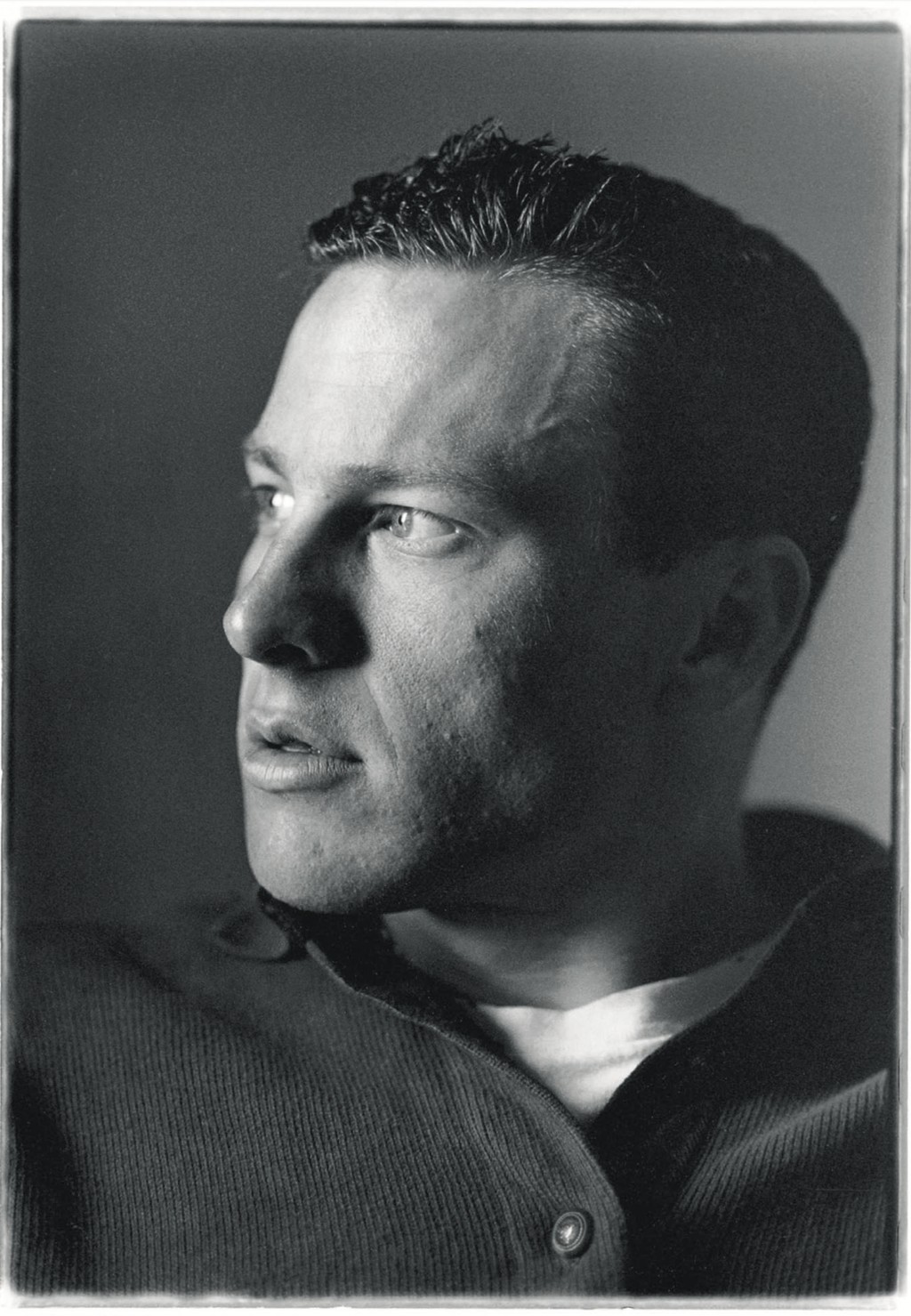
“I have always enjoyed taking portraits and this one in particular is a favourite. He still looks young and brash and a bit of a college type.
“He had the world at his feet not knowing what horror was to befall him some months later and the successes that were to follow.”

“This was Armstrong’s first Tour and the last time he would be wearing number 181. From now on only number 1 would do.
“Descending the Col de l’Homme Mort, with the Maillot Jaune on his back, his mind tuned to holding on to the race leader’s jersey until Paris. You can see every muscle in his body straining as he powers down this hill concentrating intensely.”

“This was the fog-shrouded stage in which Miguel Induráin blasted his rivals’ Tour dreams as he motored to the summit with Luc Leblanc. A pre-shaven-headed Marco Pantani finished 3rd on this stage ahead of a gasping Bjarne Riis and Tony Rominger.
“The Italian climber was heading towards a podium finish and making it clear to everybody that he was a future Tour contender. The demise of the Rominger challenge, who had prepared by training in the rarefied Colorado atmosphere, and the crushing blow inflicted by Induráin on his rivals, meant that the nature of this Tour changed.
“The press room became a miserable place where all the members of the media shrugged their shoulders and wondered what they were going to write about for the next ten days.”

“This was taken on the first day that Pantani was in yellow. On the previous day he had won a rain-lashed freezing stage to Les Deux Alpes leaving a gasping Jan Ullrich nine minutes in his wake.
“At the time Pantani’s ride was received with delight. Ullrich had been defeated and a new king was to be crowned a few weeks after winning the Giro d’Italia. This was the Tour made infamous by the Festina affair and the media and fans alike were desperate for a good news story.
“Sadly, there has been little in the way of good news for Pantani since then.”
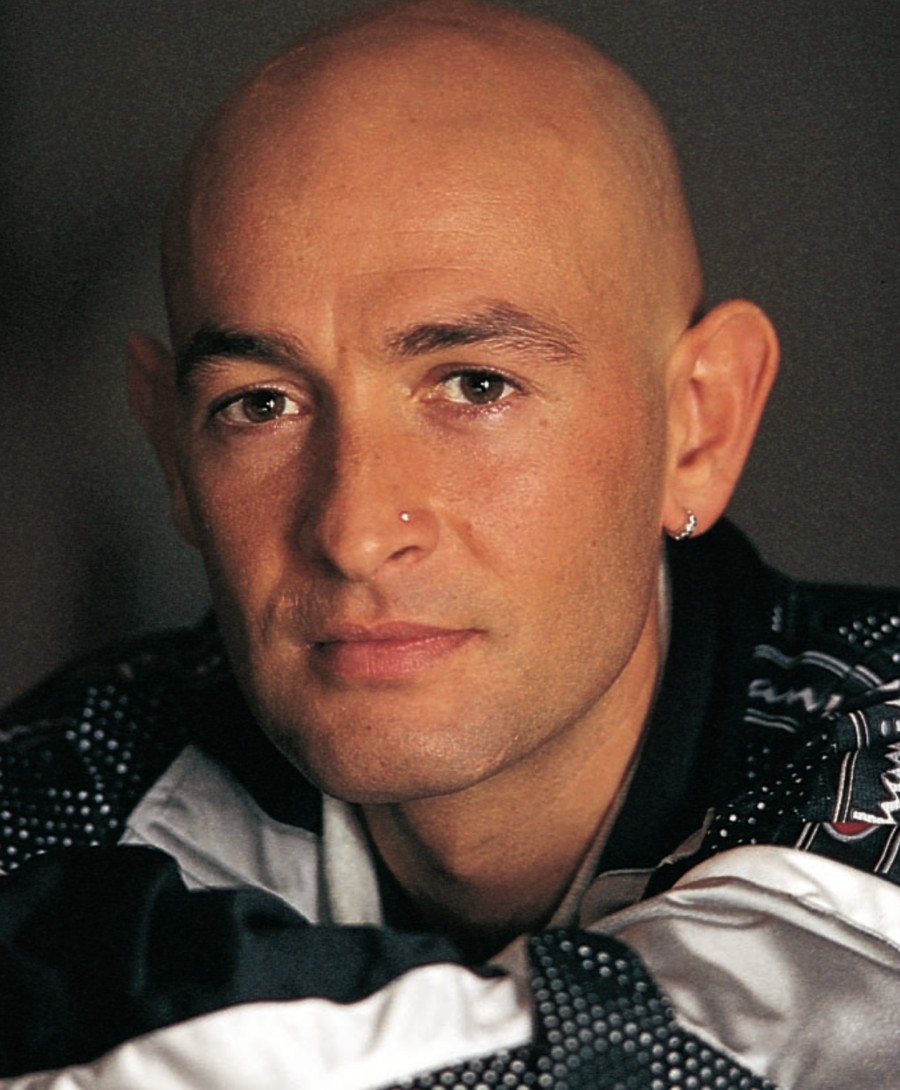
“I took this at the Mercatone-Uno training camp south of Rome. I have always been pleased with this shot.
“A journalist was doing a short interview after which I had one chance for a photo. I positioned a chair by a white wall, got him to sit on it and bounced the flash off the wall. It was all over in the time it takes to read this caption.
“One thing I have learnt over the years is to make a quick decision and live with it. Sometimes it does not work out but mostly it does.
“If you are quick with people and do not keep them waiting or keep asking them for “just one more” then they thank you for it and when you come back some months later for a photo they will usually say yes.”
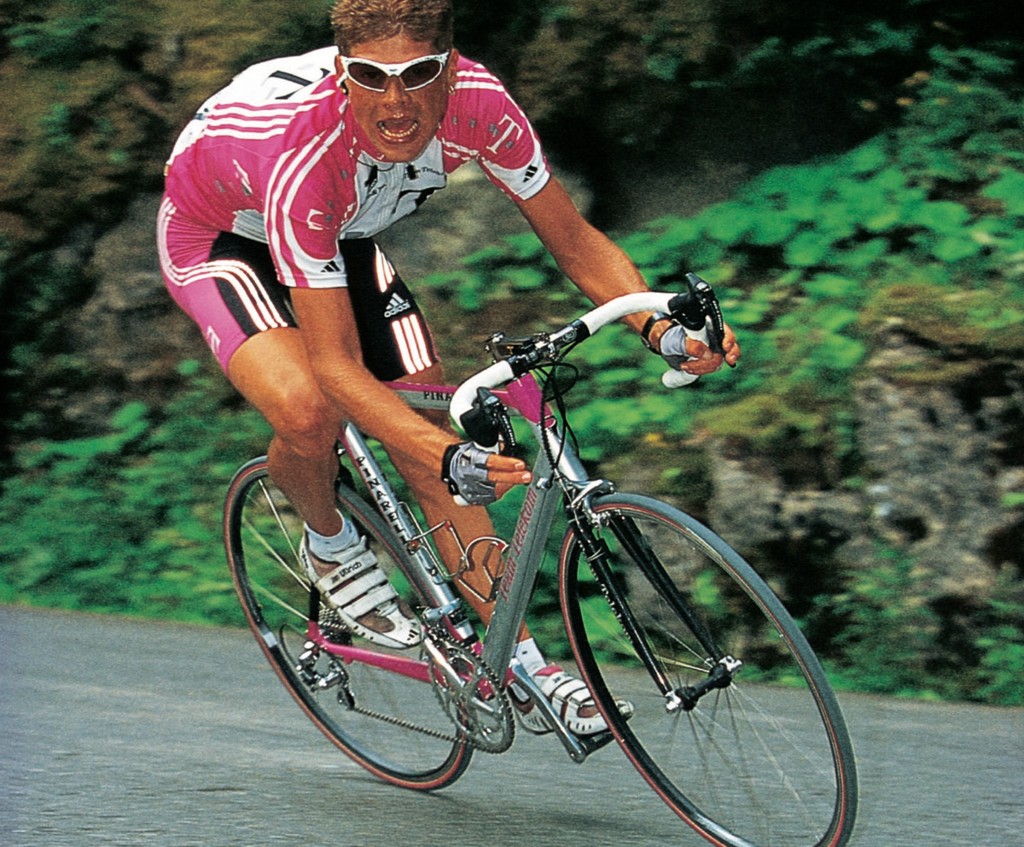
“Lance Armstrong has cracked on the ascent of the Joux Plane after an attack by Richard Virenque and Roberto Heras.
“Here on the fearsome decent into the finish at Morzine, Ullrich is frantically chasing the pair, knowing that Armstrong is in trouble behind him for the first time in this Tour. By the finish he had put in 1 minute 37 seconds into Armstrong.
“In full flight Ullrich is an impressive sight, it is just a shame that to date we have seen so little of him at his very best.
“My memory of standing on this corner, however, has nothing to do with Ullrich but everything to do with Virenque, the darling of the French fans. A minute or so after the Frenchman had hurtled past, and with Armstrong still not in sight, one woman was running around in excited little circles and shouting madly that Richard was going to win the Tour.
“Lance however, had other plans.”

“Jan is descending into Carpentras and looking confident in yellow.”

“This was taken at a press conference in Dublin Castle on the eve of the Tour.
“There had been much written in the media leading up to the start of the race about Ullrich being overweight and that he was not going to be in shape to defend his win of the previous year. Indeed, earlier in the year in Mallorca, I had taken some pictures of him where he clearly was larger than life.
“However when he walked into this press conference you could almost hear the collective intake of breath as everyone set eyes on him – this clearly was not a man who was overweight!
“Nevertheless I feel he lost the Tour on that freezing cold day to Les Deux Alpes because of the lack of depth in his preparation for the hardest sporting event in the world.
“Since that defeat he has been on a roller coaster, everything from an Olympic Gold to crashing his Porsche whilst over the alcohol limit.
“Jan is clearly a hugely talented rider and has been the only serious contender to the Armstrong era, but as time marches on it looks less and less likely that he will ever win the Tour again.”

“Miguel Induráin, Laurent Fignon and Claudio Chiappucci riding together at the foot of the Col des Aravis.
“The Tour had found a new star in Induráin who is seen here ahead of Chiappucci. The Italian would win many hearts during the Induráin era but he never found a way of winning the Tour.”
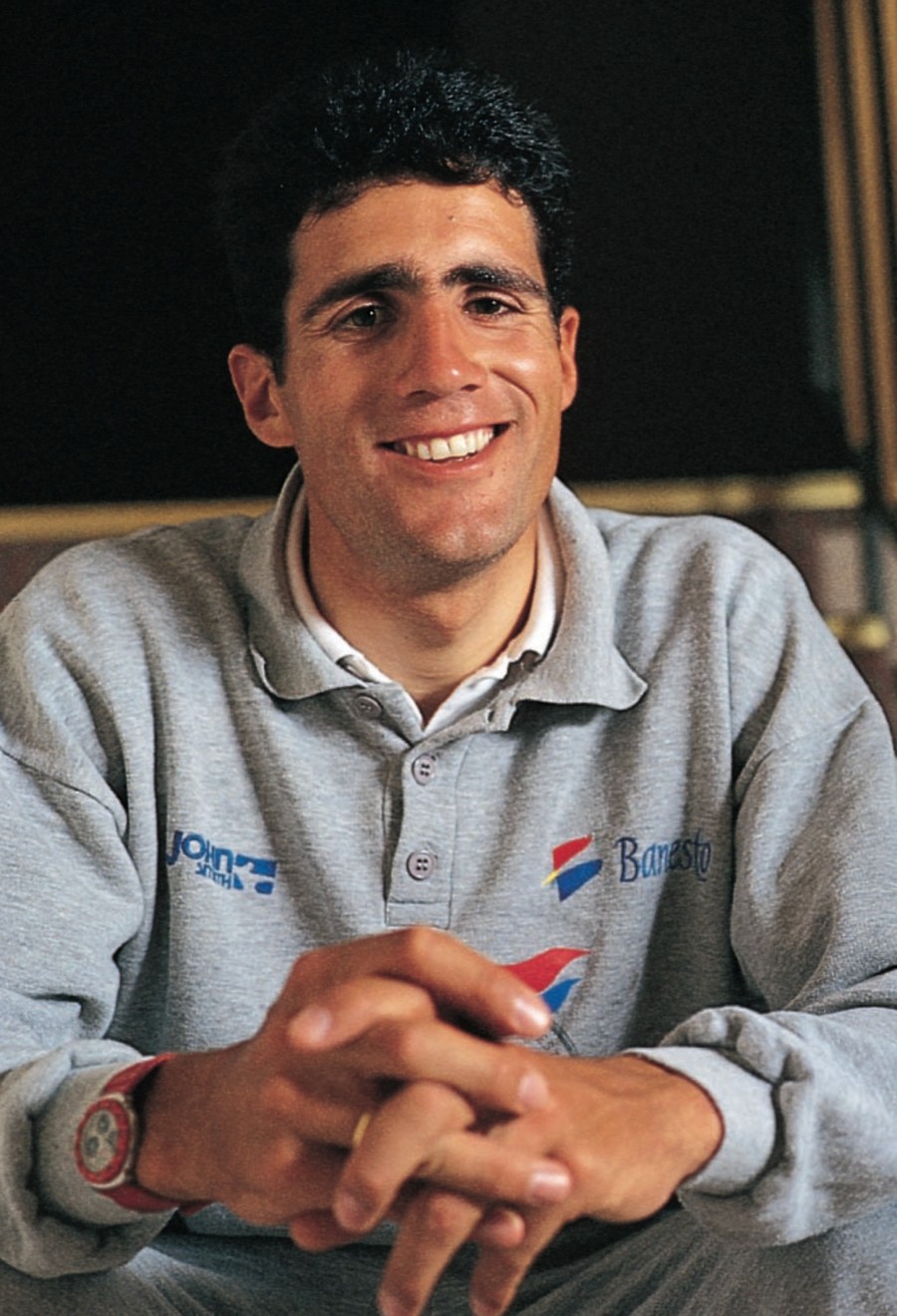
“This is Miguel looking every bit the gentleman that he was. When I shook his hand after the taking the photos I swear he had the biggest hands I had ever seen.
“Along with Kenny Pryde we had been pursuing Induráin throughout the Tour de Romandie to try and get a portrait. The team management was, as usual, putting up barriers everywhere.
“Eventually our persistence paid off and we were told to come to his hotel after an evening meal. We sat there watching the riders eat knowing that meal times can take for ever as it is often the only time they are together as a team without the stress of competition. To make things interesting I was also shooting a day in the life of Bjarn Riis which meant I had to keep nipping off to another hotel to keep that feature going.
“When I returned Miguel was still at the table with his team mates. Kenny and I were famished, so we ordered a meal which arrived at precisely the moment Miguel got up to walk away. He noticed the look of horror on our faces as we saw our quarry about to disappear into the night.
“He came over, smiled and said “tranquillo” and waited at the bar for us. I was sure that the half-smile he had on his face for the portraits was caused by the amusement he felt watching what must have looked like a couple of kids bolting their suppers.
“Miguel rarely spoke in anything other than Spanish. He could speak French but did not like to use it in case he was misquoted. Whilst I was packing my lights Kenny ventured some questions in French and Mr Tranquillo merrily chatted away to him.”
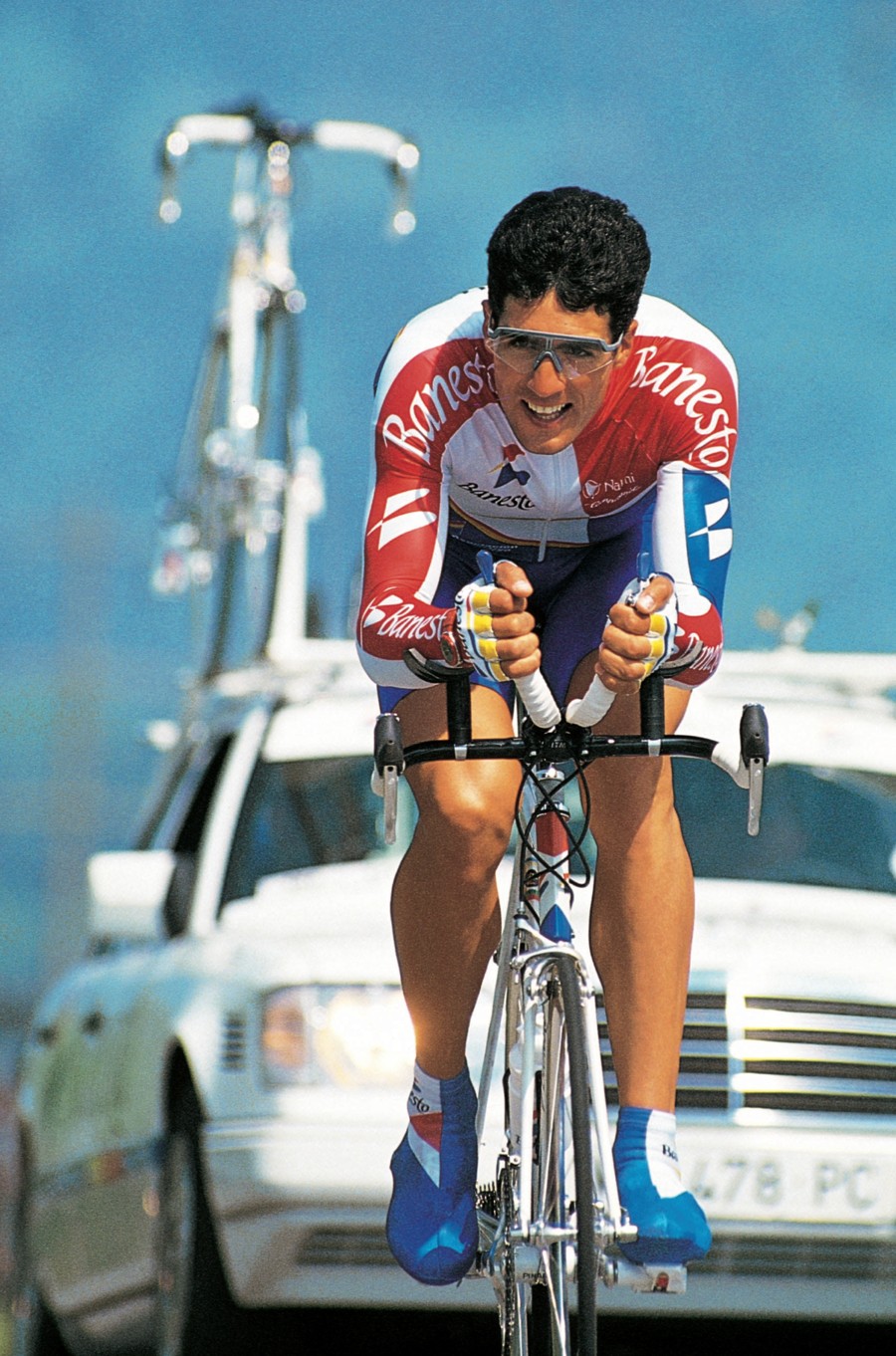
“Although this was still fairly early in Miguel’s build up to the Tour he still gave me a great picture made all the better as you can see his eyes. Too many pictures over the years have had the impact taken from them as the riders’ dark glasses have stopped you being able to see into their eyes.
“It is one of the reasons why I do not mind too much if it rains on a mountain stage as I know the riders will forget their sunglass contracts in an attempt to be able to see where they are going.”
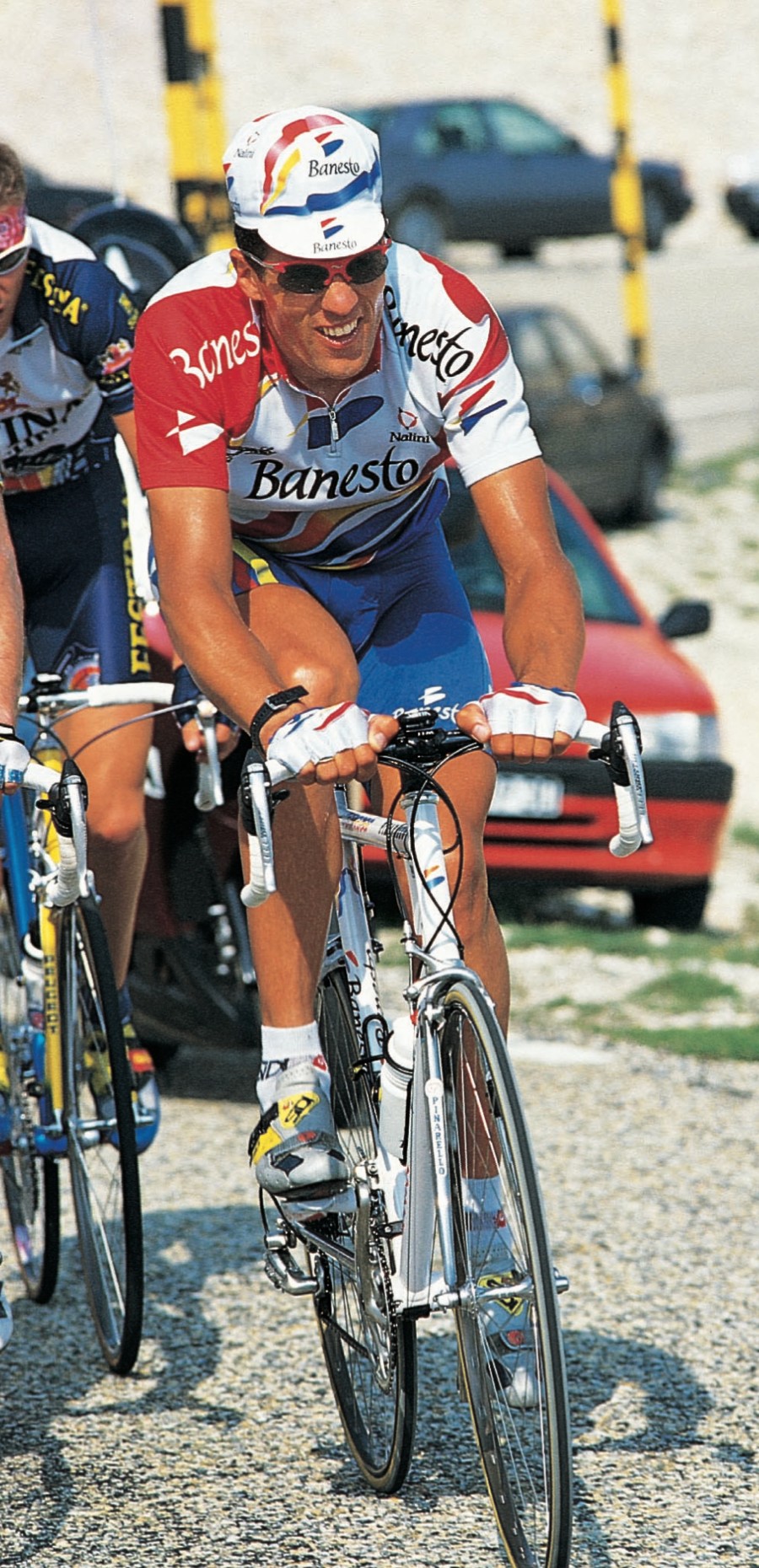
“For once the big man was apparently in trouble. Climbing Mont Ventoux he was attacked by Richard Virenque and Laurent Jalabert who combined to form a French one-two that left the Basque gasping.
“At the finish his manager sheepishly gave a ‘it’s all under control’ look to everyone who wanted to know if this was the end of his reign. Indeed the story has it that two French journalists who were working on the Giro at the time left the race to come to France fearing that they were going to miss something historic.
“I hope they made it because over the next few days they would have witnessed the final stunning moments of Induráin’s career.
“On the stage to Briançon he attacked on the descent of the Col d’Izoard and left his rivals for dead to move into the race lead. It was a stunning piece of riding which left his rivals punch drunk, when he came into the press room for the post race interview all those present rose to their feet to applaud the man in a spontaneous and heart-felt gesture.
“A few weeks later he faltered in the Tour on the stage to Les Arc in the freezing rain and his five year winning reign was over.”

“You could write an entire book about this Tour alone as so much happened. It was always exciting.
“At this point the yellow jersey of Jean-François Bernard is in trouble because of a puncture. These two have gone ahead both no doubt sensing this as the moment when they could go on to win the Tour.
“Ultimately it was to come down to a straight fight between them but not without a few twists and turns along the way.”

“This was Delgado’s first day in yellow after taking it from Stephen Roche at the top of the climb of L’Alpe d’Huez.
“Here he is looking across the valley to see how much time he has put into Roche. This picture was taken with about 5kms to go.
“What followed was extraordinary as Roche closed the gap to a few seconds by the finish line to keep his winning chances alive. It was a memorable moment in Tour history and Phil Liggett’s unmistakable commentary on Channel 4 helped to cement the event into our consciences forever.”
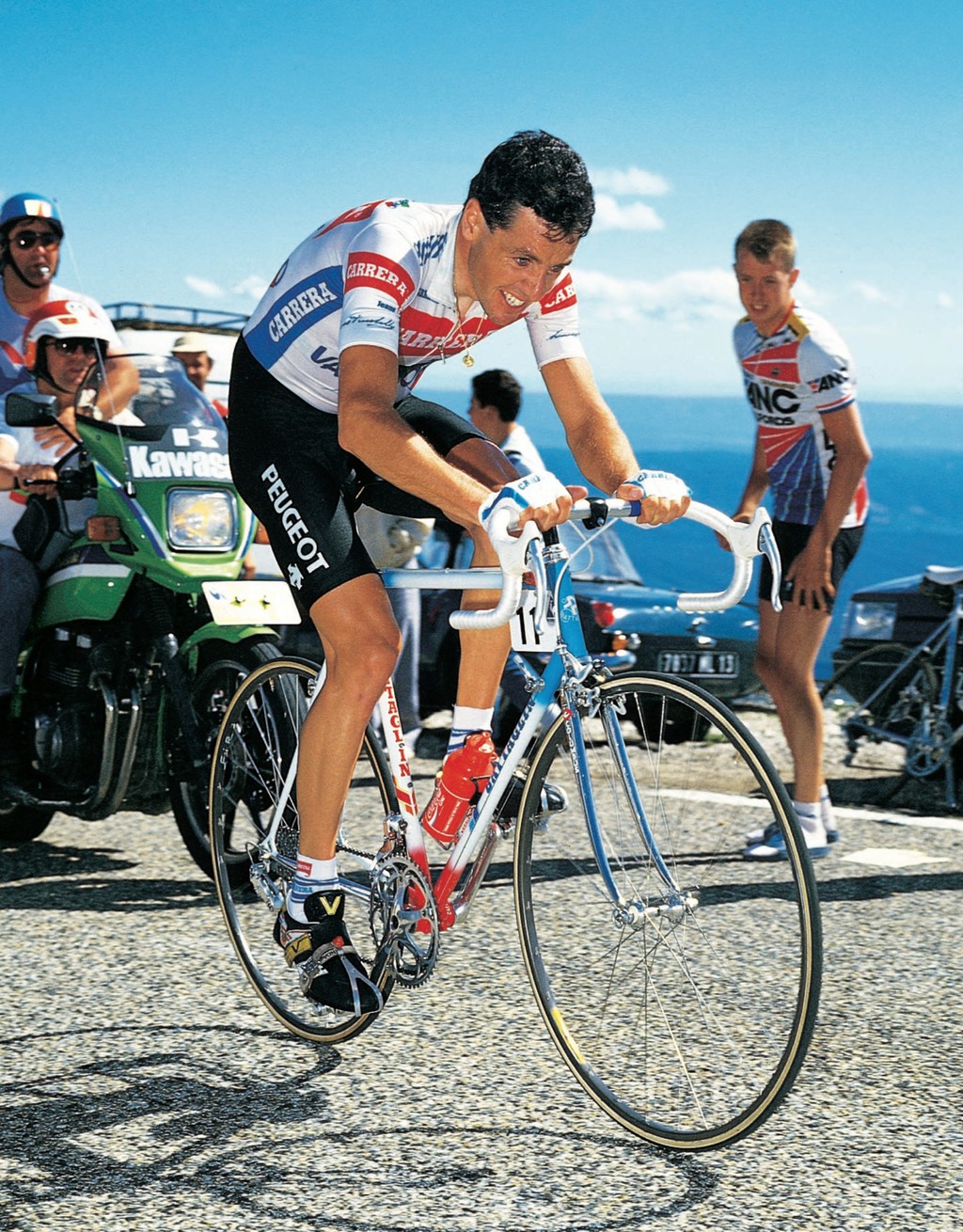
“The 1987 Tour will always be remembered for the battle between Roche and Pedro Delgado, with the jersey swapping between the two before Roche finally claimed it.
“Here the Irishman is suffering against the clock on the slopes of Mont Ventoux. The spectator wearing the ANC jersey at the side of the road is Lee Travis, who at the time was a promising young British rider.”

“This was the Irishman’s first day in yellow. Here he is seen really suffering as he digs deep to reduce his losses to Pedro Delgado who is making a bid for overall victory.
“Roche had taken the lead the day before when he joined Delgado in an audacious attack which ended France’s Jean-François Bernard’s tenure on the yellow jersey when he punctured. “
At the end of the day the jersey was to move from Roche to Delgado, but this was only temporary.’
* * *
With thanks to Phil for permission to present his images. A limited number of copies of Phil’s book are still available.
“Phil O’Connor’s 21 Years of Cycling Photography”, prologue by Phil Liggett
132 pp., illustrated, hardbound
Sportive Photo Limited, 5 Tudor Close, Grayshott, GU26 6HP, UK
ISBN 0 86388 504 7
Suggested Price: GBP £14.95
Postage: £5.50 to UK, £10.50 to Europe and £16.50 to USA
Available from: http://bit.ly/21_YEARS_BOOK
Also available from Amazon.co.uk.



